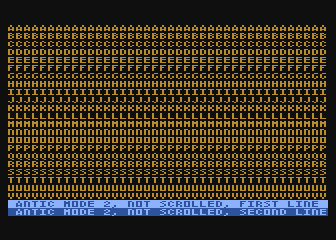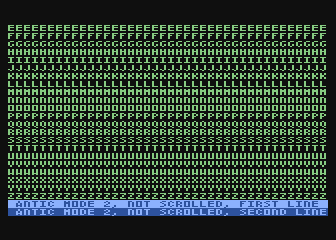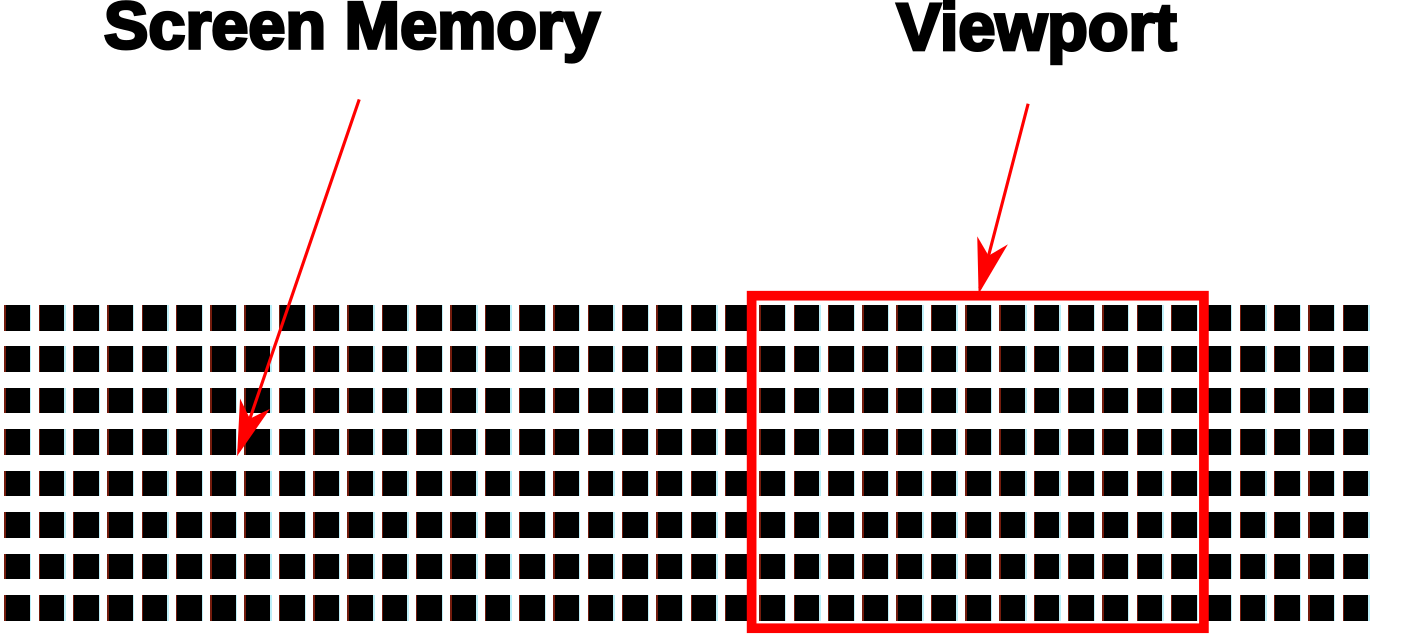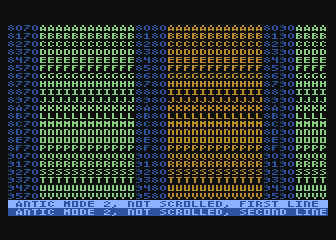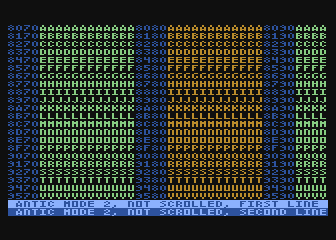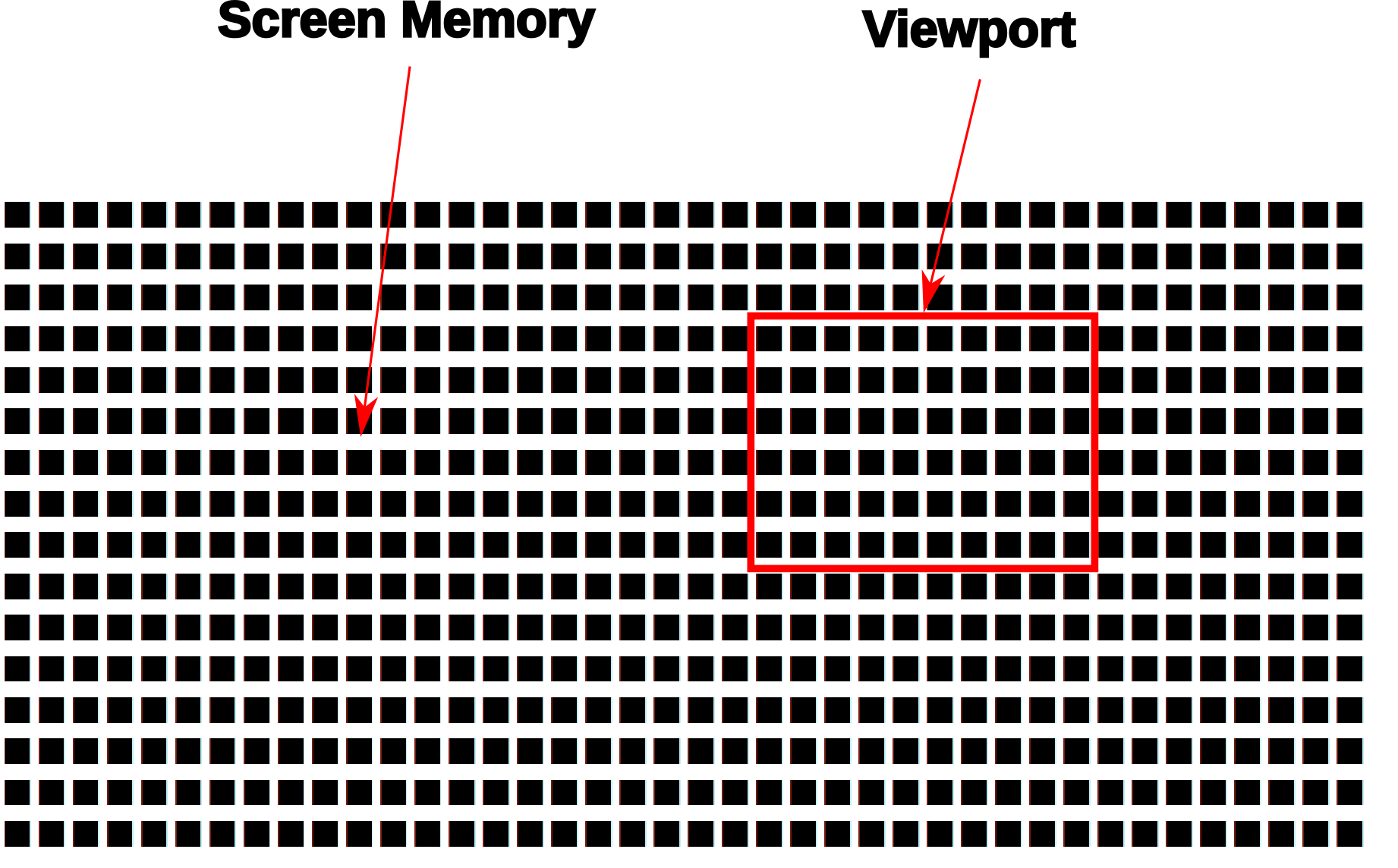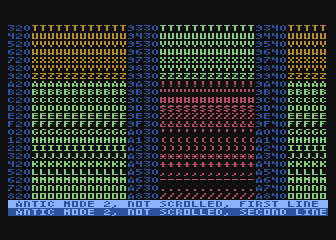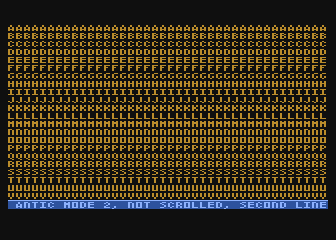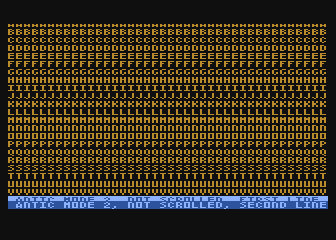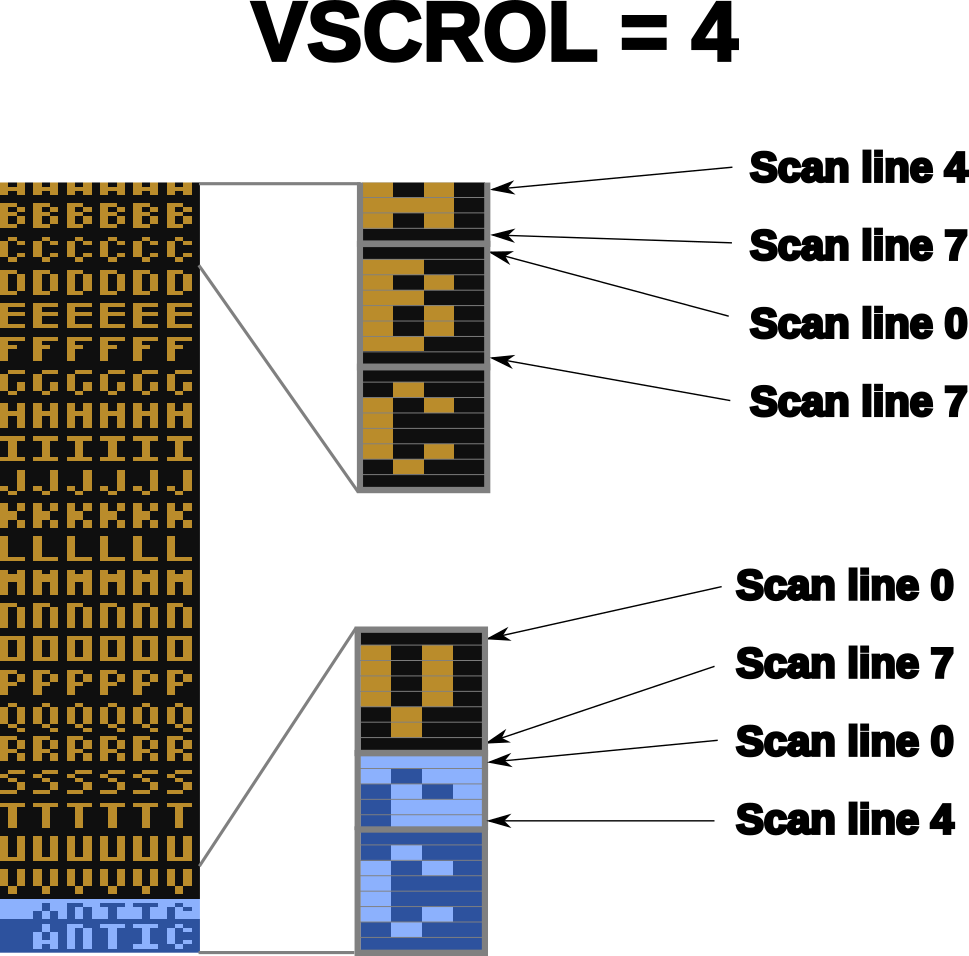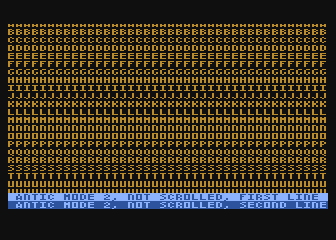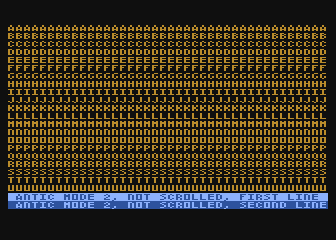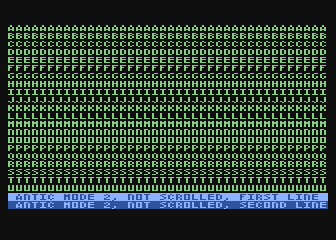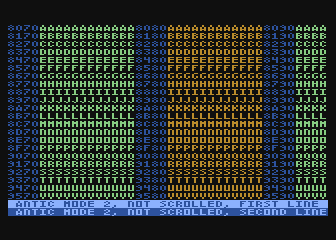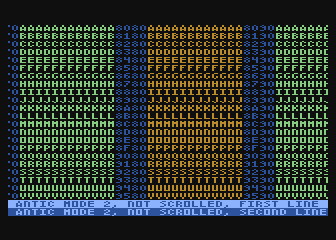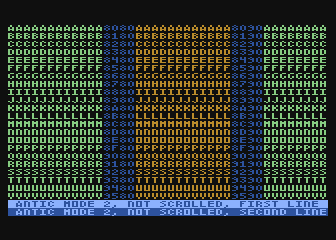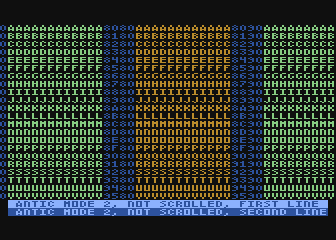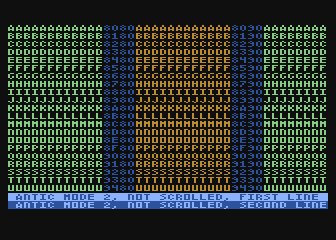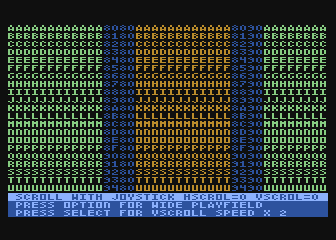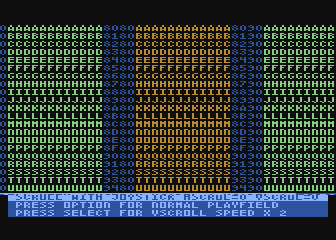Atari 8-bit Fine Scrolling: A Complete(ish) Tutorial¶
Revision 6, updated 23 Dec 2019
This is a tutorial on fine scrolling for the Atari 8-bit series of computers. In a nutshell, the ANTIC coprocessor provides 2D hardware scrolling at very little computational expense.
Scrolling means the display screen is a window or viewport on a larger map. At any moment in time, the user is looking at only a small portion of the overall area, and this viewport can be moved around. The Atari hardware provides for both coarse scrolling (that is, moving the viewport at byte or character boundaries) and fine scrolling (moving with higher resolution: scan lines vertically and color clocks horizontally). Fine scrolling on the Atari is built upon coarse scrolling, so we will first examine the latter before make the scrolling smooth by tackling the former.
No prior knowledge of scrolling is necessary before reading this tutorial. However, this is advanced programming tutorial in the sense that the examples are written in assembly language, so the assumption will be that you are comfortable with that. All the examples here are assembled using the MAC/65-compatible assembler ATasm (and more specifically to this tutorial, the version built-in to Omnivore).
Note
All source code and XEX files are available in the scrolling_tutorial source code repository on github.
Note
This tutorial is Copyright © 2019 and licensed under the CC BY-SA 4.0, except for the assembly language source code (both in this tutorial and in the repository), which is placed in the public domain via CC0.
See also
Here are some resources for learning more about scrolling:
A Refresher on Display Lists¶
Display lists are an important topic for scrolling, because certain flags on display list commands tell ANTIC which lines get scrolled and which are left alone. For a summary, check out my tutorial on DLIs which has a large section on display list instructions. A small amount of relevant detail is repeated here.
An ANTIC display list instruction consists of 1 byte with an optional 2 byte address. There are 3 types of instructions: blank lines, graphics modes, and jump instructions. Instructions are encoded into the byte using a bitmask where low 4 bits encode the graphics mode or feature and the high 4 bits encode the flags that affect that instruction:
7
6
5
4
3
2
1
0
DLI
LMS
VSCROLL
HSCROLL
Mode
The 4 flags are:
DLI (
$80): enable a display list interrupt when processing this instructionLMS (
$40): trigger a Load Memory Scan, changing where ANTIC looks for screen data, and requires an additional 2 byte address immediately following this instruction byte.VSCROLL (
$20): enable vertical scrolling for this mode lineHSCROLL (
$10): enable horizontal scrolling for this mode line
There are 14 available graphics modes, which are encoded into low 4 bits. This tutorial is only going to focus on three of the text modes. Any mode can be scrolled horizontally, and modes taller than 1 scan line can also be scrolled vertically, but the combination of low memory usage and large height of the text modes make them ideal candidates for scrolling games.
Mode |
Decimal |
BASIC Mode |
Description |
Scan Lines |
Type |
Colors |
2 |
02 |
0 |
40 x 24 |
8 |
text |
2 |
4 |
04 |
n/a |
40 x 24 |
8 |
text |
5 |
5 |
05 |
n/a |
40 x 12 |
16 |
text |
5 |
See also
More resources about display lists are available:
The Display Lists section of my DLI tutorial
The SDLSTL memory location in Mapping the Atari
Appendix 8 of Mapping the Atari
Introduction to Scrolling¶
Scrolling on the Atari can be broken up into two categories: coarse scrolling and fine scrolling.
Coarse scrolling is scrolling at character or byte boundaries and will appear
on screen as large jumps in position. It can be accomplished without any use of
the hardware scrolling registers. In fact, coarse scrolling falls out as a
side- effect of the LMS bit on display list commands. Being able to
reposition the memory pointer for any display list instruction means that you
can tell ANTIC where to look in memory when it draws a scan line. Simply by
moving the address pointer to a different location, you can change the display.
Fine scrolling is moving the viewport in steps that are smaller than a byte, giving the appearance of a smoothly sliding playfield, rather than one that jumps from position to position.
First we will look at vertical coarse scrolling which is the simpler case than horizontal coarse scrolling. After examining horizontal coarse scrolling, we will combine the two which will give us unrestricted 2D scrolling. Fine scrolling is then built on top of coarse scrolling and will be addressed similarly: first horizontal, then vertical, and finally combined to give us an omnidirectional scrolled playfield.
Definitions¶
It helps to set up what we mean by the directions, because depending on your perspective, scrolling up and scrolling down (and similarly left and right) could mean exactly opposite things. Are the directions referring to which way the data is moving on the screen? Or which way the viewport is moving over the larger screen memory layout?
The convention is to refer to the direction as the way the viewport is moving. So, scrolling up means the viewport is moving up over the screen memory layout, but what that means in terms of what’s displayed is that new data is appearing at the top of the screen, pushing everything else down the screen and old data is vanishing off the bottom of the screen.
Note
Because there are so many types of lines, the word by itself can be ambiguous. In places where I use the word, I will attempt to clarify which sense of “line” I mean:
scan lines on screen
number of scan lines in a character cell
lines of characters in the viewport
lines of characters in the screen memory layout
Topic #1: Vertical Coarse Scrolling¶
Coarse scrolling vertically is moving the playfield data such that the user
sees a new line of information on the top of the screen while the line that was
previously on the on the bottom of the screen moves off, and all other visible
lines move down one line. (Or vice-versa: new data appears on the bottom while
a line is removed from the top.) This direction is simpler than horizontal
because only a single LMS instruction needs to be updated, so that is where
we will start.
Memory Layout¶
To move a viewport window up or down over a larger map doesn’t require any difference in memory layout for the screen data, just more of it.
Preparing the Display List¶
Here is a display list without any scrolling, and just a single instruction
with LMS set in the main region of mode 4 lines. That LMS tells ANTIC
where to look in memory for that first line and all subsequent lines until another LMS instruction is encountered.
- Source Code: coarse_no_scroll_dlist.s
- Executable: coarse_no_scroll_dlist.xex
All this test program does is create a display list and show a simple test
pattern. There is nothing special about this display list, no scrolling bits
set on any display list instructions; only the LMS instruction to set the
initial memory location for the 22 lines of ANTIC Mode 4 that will become the
scrolling region in further examples, and another LMS for the two lines of
ANTIC mode 2 at the bottom for non-scrolling status lines.
; Simple display list to be used as coarse scrolling comparison
dlist_coarse_mode4
.byte $70,$70,$70 ; 24 blank lines
.byte $44,$00,$80 ; Mode 4 + LMS + address
.byte 4,4,4,4,4,4,4,4 ; 21 more Mode 4 lines
.byte 4,4,4,4,4,4,4,4
.byte 4,4,4,4,4
.byte $42,<static_text, >static_text ; 2 Mode 2 lines + LMS + address
.byte $2
.byte $41,<dlist_coarse_mode4,>dlist_coarse_mode4 ; JVB ends display list
#1.1: Coarse Scrolling Down¶
Scrolling down means new data is appearing at the bottom of the screen, pushing data currently on the screen upwards and finally disappearing off the top of the screen:
- Source Code: coarse_scroll_down.s
- Executable: coarse_scroll_down.xex
This is accomplished by updating the start address that ANTIC sees for the first line.
; move viewport one line down by pointing display list start address
; to the address 40 bytes further in memory
coarse_scroll_down
clc
lda dlist_coarse_address
adc #40
sta dlist_coarse_address
lda dlist_coarse_address+1
adc #0
sta dlist_coarse_address+1
rts
Adding 40 bytes to that address will move the starting point one line higher in memory, moving what was the 2nd line being displayed to the first line and a line previously off-screen to the 22nd line. This gives the appearance of the playfield window moving down across the map.
The code needs a timing loop so the scrolling doesn’t happen too fast:
loop
ldx #15 ; number of VBLANKs to wait
?start lda RTCLOK+2 ; check fastest moving RTCLOCK byte
?wait cmp RTCLOK+2 ; VBLANK will update this
beq ?wait ; delay until VBLANK changes it
dex ; delay for a number of VBLANKs
bpl ?start
; enough time has passed, scroll one line
jsr coarse_scroll_down
jmp loop
This delay loop simply waits for a number of vertical blank intervals to pass, then updates the screen memory pointer.
#1.2: Coarse Scrolling Up¶
Scrolling up means new data is appearing at the top of the screen, pushing data currently on the screen downwards and finally disappearing off the bottom of the screen:
- Source Code: coarse_scroll_up.s
- Executable: coarse_scroll_up.xex
This is accomplished using exactly the same method of changing the start address that ANTIC uses for the screen memory:
; move viewport one line up by pointing display list start address
; to the address 40 bytes earlier in memory
coarse_scroll_up
sec
lda dlist_coarse_address
sbc #40
sta dlist_coarse_address
lda dlist_coarse_address+1
sbc #0
sta dlist_coarse_address+1
rts
But instead of adding 40 bytes, we subtract 40 bytes from the address to move the starting point one line prior in memory, moving what was the 1st line being displayed to the 2nd line and a line previously off-screen to the 1st line. This gives the appearance of the playfield window moving up across the map.
Topic #2: Horizontal Coarse Scrolling¶
Horizontal coarse scrolling is only slightly more complicated than vertical
coarse scrolling because multiple LMS addresses need to be updated.
Memory Layout¶
Scrolling left and right does present a different problem, because if only the
first LMS address is updated, a subsequent line will use memory immediately
following the previous line, resulting in a snake-like movement that doesn’t
resemble scrolling.
To remedy this, the memory should be thought of as individual horizontal
strips, which for ANTIC to process correctly requires LMS addresses on
every display list line in the scrolling region.
For this tutorial, the horizontal memory layout is going to use an entire page
of memory (256 bytes, so 256 characters) per line of screen memory. At the cost
of some RAM, this will simplify our LMS modifications in that only the low
byte will need to be modified in the case of pure horizontal scrolling, and
only the high byte needs to change in the case of pure vertical scrolling.
This is a tradeoff that is good for speed and reduced code complexity, but if
your memory constraints outweigh your speed requirements, this may not be a
tradeoff you are willing to make. The byte width of your screen memory layout
is entirely arbitrary; the LMS calculations will just be more complicated
(and therefore slower) with widths where you must do arithmetic to calculate
the addresses.
#2.1: Coarse Scrolling Left¶
Scrolling left means new data is appearing on the left of the screen, pushing data currently on the screen to the right and finally disappearing off the right side of the screen. Every 16 bytes, the memory layout has been stamped with the hex addresses of the screen memory so you can tell where the viewport has scrolled to.
- Source Code: coarse_scroll_left.s
- Executable: coarse_scroll_left.xex
Because each LMS address in the scrolling region and the one-line buffer
zone must be updated, a loop is used here. Moving to the left means moving
lower in memory, in this case: one byte at a time:
; move viewport one byte to the left by pointing each display list start
; address to one byte lower in memory
coarse_scroll_left
ldy #22 ; 22 lines to modify
ldx #4 ; 4th byte after start of display list is low byte of address
?loop dec dlist_lms_mode4,x
inx ; skip to next low byte which is 3 bytes away
inx
inx
dey
bne ?loop
rts
There’s no bounds checking in this example, so if you let it run long enough it
will display low byte address moves from $00 to
$ff. “Defender”-style wrapping, to make it appear like there is no start or
end, takes some special preparations and will be discussed below.
Here’s the display list:
; one page per line, used for coarse scrolling. Start visible region
; in middle of each page so it can scroll either right or left immediately
; without having to check for a border
dlist_lms_mode4
.byte $70,$70,$70
.byte $44,$70,$80 ; first line of scrolling region
.byte $44,$70,$81
.byte $44,$70,$82
.byte $44,$70,$83
.byte $44,$70,$84
.byte $44,$70,$85
.byte $44,$70,$86
.byte $44,$70,$87
.byte $44,$70,$88
.byte $44,$70,$89
.byte $44,$70,$8a
.byte $44,$70,$8b
.byte $44,$70,$8c
.byte $44,$70,$8d
.byte $44,$70,$8e
.byte $44,$70,$8f
.byte $44,$70,$90
.byte $44,$70,$91
.byte $44,$70,$92
.byte $44,$70,$93
.byte $44,$70,$94
.byte $44,$70,$95 ; last line with scroll bit set
.byte $42,<hscroll_static_text, >hscroll_static_text ; 2 Mode 2 lines + LMS + address
.byte $2
.byte $41,<dlist_lms_mode4,>dlist_lms_mode4 ; JVB ends display list
#2.2: Coarse Scrolling Right¶
Scrolling right means new data is appearing on the right of the screen, pushing data currently on the screen to the left and finally disappearing off the left side of the screen.
- Source Code: coarse_scroll_right.s
- Executable: coarse_scroll_right.xex
The code for this is exactly analogous to scrolling left, except we are
incrementing the LMS pointer, moving one byte higher in memory to push the
viewport to the right.
; move viewport one byte to the right by pointing each display list start
; address to one byte higher in memory
coarse_scroll_right
ldy #22 ; 22 lines to modify
ldx #4 ; 4th byte after start of display list is low byte of address
?loop inc dlist_lms_mode4,x
inx ; skip to next low byte which is 3 bytes away
inx
inx
dey
bne ?loop
rts
The display list is exactly the same as in the scrolling left example.
Topic #3: Combined Coarse Scrolling¶
Simultaneous horizontal and vertical coarse scrolling is possible with very little additional effort over horizontal coarse scrolling alone.
Adding vertical scrolling to a display list that uses LMS addresses for
every line means that, unlike the simple vertical scrolling that used a single
LMS address for the whole screen, every display list line in the
scrolling region will have to be modified to point to a new vertical location
in the memory layout.
Memory Layout¶
Combining horizontal and vertical scrolling requires combining the memory layout ideas: wide horizontal lines coupled with lines above and below the viewport.
As in the horizontal scrolling examples above, the combined scrolling examples will also use the page-per-line memory layout: 256 bytes per line.
Horizontal coarse scrolling requires an LMS address for every display list
line in the scrolling region, and using this memory layout means that the low
byte of that address is modified for every scroll. The high byte is unmodified.
Vertical coarse scrolling using this display list and memory layout is convenient because the vertical position of the viewport is solely dependent on the high byte of the memory address; the low byte is unchanged.
This memory layout simplifies combined scrolling because it decouples the
vertical position and horizontal position! Combined scrolling is then reduced
to changing the high byte of each LMS address to reflect the vertical
location of the viewport, and changing the low byte to set the horizontal
location.
#3.1: 2D Coarse Scrolling¶
This example scrolls the viewport simultaneously in the vertical and horizontal directions using the techniques described above.
- Source Code: coarse_scroll_2d.s
- Executable: coarse_scroll_2d.xex
The display list is unchanged from the horizontal coarse scrolling examples.
There are several differences in code from the horizontal scrolling version. First some variables are added to track the direction at which the viewport is moving (and they are initialized):
horz_dir = $80 ; 1 = right, $ff = left
vert_dir = $81 ; 1 = down, $ff = up
lda #$ff
sta horz_dir
lda #1
sta vert_dir
We will need to track where the viewport is on screen, and instead of creating
extra variables for it, we can realize that the display list itself will tell
us where the viewport is. Choosing the reference point to be the upper left
corder of the viewport window means that the very first LMS instruction in
the display list is exactly our reference point. The low byte of the LMS
address is the horizontal position and the high byte is the vertical.
; representative values for vertical and horizontal scrolling: the pointers
; to the display list LMS addresses themselves
horz_ref = dlist_lms_mode4 + 4
vert_ref = dlist_lms_mode4 + 5
The code that moves the viewport horizontally checks the horizontal direction
before determining how to changing the low bytes of the LMS addresses:
; move viewport one byte to the left/right by pointing each display list
; address to one lower/byte higher in memory (i.e. changing low byte)
coarse_scroll_horz
ldy #22 ; 22 lines to modify
ldx #0
lda horz_dir
bmi ?left
?right inc horz_ref,x ; low bytes of display list referenced at this addr
inx ; skip to next low byte which is 3 bytes away
inx
inx
dey
bne ?right
rts
?left dec horz_ref,x ; low bytes of display list referenced at this addr
inx ; skip to next low byte which is 3 bytes away
inx
inx
dey
bne ?left
rts
Vertical scrolling changes the high bytes of the LMS addresses lines. The
code is very similar to the above:
; move viewport one line up/down by pointing each display list address
; one *page* lower/byte higher in memory (i.e. changing high byte)
coarse_scroll_vert
ldy #22 ; 22 lines to modify
ldx #0
lda vert_dir
bmi ?up
?down inc vert_ref,x ; high bytes of display list referenced at this addr
inx ; skip to next high byte which is 3 bytes away
inx
inx
dey
bne ?down
rts
?up dec vert_ref,x ; high bytes of display list referenced at this addr
inx ; skip to next high byte which is 3 bytes away
inx
inx
dey
bne ?up
rts
Some boundary checking is added referencing some constants describing the limits of the memory layout, and the viewport bounces off the sides as if it were a pong game.
horz_min = 0 ; horizontal lower bound
horz_max = 255-44 ; horizontal upper bound is page width, less some extra to prevent unintentional wraparound
vert_min = $80 ; page $80 is first line in memory region
vert_max = $80+52-22 ; 52 lines high and 22 visible at a time
; check if horizontal direction needs updating
lda horz_ref ; reference horizontal position
cmp #horz_max ; too far to the right?
bcc ?ck_left
lda #$ff ; yep, start scrolling left
sta horz_dir
bne ?ck_down
?ck_left cmp #horz_min ; at left boundary?
bne ?ck_down
lda #1 ; yep, start scrolling right
sta horz_dir
; check if vertical direction needs updating
?ck_down lda vert_ref ; reference vertical position
cmp #vert_max ; too far to down?
bcc ?ck_up
lda #$ff ; yep, start scrolling up
sta vert_dir
bne ?scroll
?ck_up cmp #vert_min+1 ; at top boundary?
bcs ?scroll
lda #1 ; yep, start scrolling down
sta vert_dir
Topic #4: Vertical Fine Scrolling¶
Vertical fine scrolling is controlled by ANTIC’s VSCROL hardware register.
The register can be any number from 0 - 15 representing the number of scan
lines to scroll. ANTIC accomplishes scrolling not by moving the display list up
and down by a number of scan lines, but by using the VSCROL value to skip
that number of scan lines in the first line of the display list, essentially
shortening the number of displayed lines.
This will become more clear with an example. First, let’s see what happens just by turning on the vertical scrolling bit on a display list.
Preparing the Display List¶
Here’s the same program used in the coarse vertical scrolling section, except now the vertical scrolling bit has been set on the display list instructions for the scrolling region of lines A through V. Notice the first line of the mode 2 status lines at he bottom seems to be missing! Actually, it is still there, or more correctly: one scan line of it is still there.
- Source Code: fine_vscroll_dlist.s
- Executable: fine_vscroll_dlist.xex
Note that the VSCROL hardware register is set to zero. Here’s the display list:
; Simple display list to be used as coarse scrolling comparison
dlist_coarse_mode4
.byte $70,$70,$70 ; 24 blank lines
.byte $44,$00,$80 ; Mode 4 + LMS + address
.byte $64,$00,$80 ; Mode 4 + VSCROLL + LMS + address
.byte $24,$24,$24,$24,$24,$24,$24,$24 ; 21 more Mode 4 + VSCROLL lines
.byte $24,$24,$24,$24,$24,$24,$24,$24
.byte $24,$24,$24,$24,$24
.byte $42,<static_text, >static_text ; 2 Mode 2 lines + LMS + address
.byte $2
.byte $41,<dlist_coarse_mode4,>dlist_coarse_mode4 ; JVB ends display list
So what is the mystery of the (mostly) missing mode 2 line at the bottom? ANTIC uses the first scan line that doesn’t have the vertical scrolling bit set as a sort-of buffer zone to the scrolling region.
Here’s the same example, except the VSCROL register is set to 4:
where it shows that 4 scan lines of line A have been scrolled off the screen and the first ANTIC mode 2 line shows 4 of its 8 scan lines.
The VSCROL Hardware Register¶
The VSCROL hardware register at $d405 controls how many scan lines are
shifted for fine scrolling. The value tells ANTIC on which scan line to start
rendering for the first display list instruction it encounters with the
vertical scrolling bit set. Subsequent lines in the display list that have the
vertical scrolling bit set are fully rendered, but because that initial scan
line was rendered with fewer scan lines, the display has appeared to move up.
What confused the author until reading section 4.7 in the Altirra Hardware Reference Manual
is that VSCROL value also controls where ANTIC stops rendering on that
buffer zone display list instruction: it renders scan lines up to and
including that value.
In the first example, VSCROL = 0. ANTIC mode 4 lines are 8 scan lines tall,
and for scrolling purposes the height of a mode line is enumerated from 0, so
an 8 scan line tall text mode has scan lines numbered 0 through 7. For the
example, the rendering of line A starts at scan line zero of the text mode. The
buffer zone mode 2 line that is only rendered with a single scan line: it
stopped rendering after rendering scan line zero of that mode 2 line.
The second example uses VSCROL set to 4, here shown in detail:
The first display list line with the vertical scrolling bit set, Line A, is rendered starting from scan line 4 (again, as enumerated from zero: scan lines 0, 1, 2, and 3 are skipped and 4, 5, 6, and 7 are rendered). All subsequent lines with their vertical scroll bit set have all 8 scan lines rendered. The buffer zone, that is: the first display list line without the scroll bit set, is rendered through scan line 4 as enumerated from zero, so scan lines 0, 1, 2, 3, and 4. Scan lines 5 through 7 are not rendered.
See also
Section 4.7 in the Altirra Hardware Reference Manual
Fixing the Last Scrolled Line¶
Having the scrolled region extend into the status lines at the bottom of the previous example is obviously not what’s intended. This example fixes that problem:
- Source Code: fine_vscroll_better_dlist.s
- Executable: fine_vscroll_better_dlist.xex
The solution is to clear the vertical scrolling bit on the final mode 4 line in
the scrolling region. Here’s the new display list with only a single byte
changed: the final $24 in the previous example is changed to a normal mode
4 line:
; Simple display list to be used as coarse scrolling comparison
dlist_coarse_mode4
.byte $70,$70,$70 ; 24 blank lines
.byte $44,$00,$80 ; Mode 4 + LMS + address
.byte $64,$00,$80 ; Mode 4 + VSCROLL + LMS + address
.byte $24,$24,$24,$24,$24,$24,$24,$24 ; 20 more Mode 4 + VSCROLL lines
.byte $24,$24,$24,$24,$24,$24,$24,$24
.byte $24,$24,$24,$24
.byte 4 ; and the final Mode 4 without VSCROLL
.byte $42,<static_text, >static_text ; 2 Mode 2 lines + LMS + address
.byte $2
.byte $41,<dlist_coarse_mode4,>dlist_coarse_mode4 ; JVB ends display list
This leaves the status lines with two complete mode 2 lines, and the scrolling
playfield as 21 mode 4 lines, and a one line buffer zone, this time of mode
4. In this case, VSCROL = 4, so the first scrolled line is rendered
starting at its scan line 4 and the buffer zone line is rendered through its
scan line 4, we are missing 7 scan lines from the same display list without any
vertical scrolling bits.
Note
The number of scan lines ANTIC will generate is reduced by vertical scrolling. The total number of scan lines can be counted by setting VSCROL = 0, meaning the buffer zone line will be reduced to a single scan line. Changes to VSCROL don’t change the total number of lines generated, for instance: setting VSCROL = 2 reduces the first scrolled line to 6 scan lines but increases the buffer zone to 3 scan lines, resulting in the same net number of scan lines in the scrolling + buffer zone regions.
#4.1: Fine Scrolling Down¶
We can now add the VSCROL hardware register to the coarse scrolling demo to
produce fine scrolling:
- Source Code: fine_scroll_down.s
- Executable: fine_scroll_down.xex
The code for this example is largely the same as the coarse scroll down demo, which a few minor additions. We need one
additional variable to keep our own copy of the hardware scrolling register,
since VSCROL is a write-only register:
vert_scroll = $90 ; variable used to store VSCROL value
vert_scroll_max = 8 ; ANTIC mode 4 has 8 scan lines
The init code from the demo also needs to initialize the variable:
lda #0 ; initialize vertical scrolling value
sta vert_scroll
sta VSCROL ; initialize hardware register
and the main loop calls the fine scrolling routine instead of the coarse scrolling routine.
loop ldx #delay ; number of VBLANKs to wait
?start lda RTCLOK+2 ; check fastest moving RTCLOCK byte
?wait cmp RTCLOK+2 ; VBLANK will update this
beq ?wait ; delay until VBLANK changes it
dex ; delay for a number of VBLANKs
bpl ?start
; enough time has passed, scroll one scan line
jsr fine_scroll_down
jmp loop
The fine_scroll_down routine takes care of updating the fine scrolling
variable and setting the hardware VSCROL register. If it has scrolled 8
scan lines, it calls the coarse_scroll_down routine, which is unchanged
from the coarse scrolling demo.
; scroll one scan line down and check if at VSCROL limit
fine_scroll_down
inc vert_scroll
lda vert_scroll
cmp #vert_scroll_max ; check to see if we need to do a coarse scroll
bcc ?done ; nope, still in the middle of the character
jsr coarse_scroll_down ; yep, do a coarse scroll...
lda #0 ; ...followed by reseting the vscroll register
sta vert_scroll
?done sta VSCROL ; store vertical scroll value in hardware register
rts
#4.2: Fine Scrolling Up¶
The code for fine scrolling the viewport up has very few changes from the above.
- Source Code: fine_scroll_up.s
- Executable: fine_scroll_up.xex
The delay loop is the same, just calling the subroutine to do a fine scroll up
instead of down. The logic does change a little bit, as we are now decrementing
the vert_scroll variable. Since zero is a valid value for the VSCROL
hardware register, we check to see when the decrement wraps back to $ff to
determine if a coarse scroll needs to happen:
; scroll one scan line up and check if at VSCROL limit
fine_scroll_up
dec vert_scroll
lda vert_scroll
bpl ?done ; if non-negative, still in the middle of the character
jsr coarse_scroll_up ; wrapped to $ff, do a coarse scroll...
lda #vert_scroll_max-1 ; ...followed by reseting the vscroll register
sta vert_scroll
?done sta VSCROL ; store vertical scroll value in hardware register
rts
The only other change is pointing the initial display list LMS address to a
line further down in the memory layout so there is scrolling room as the
viewport moves up.
Interlude: Wide and Narrow Playfields¶
Normal display lists for mode 4 are 40 bytes wide, producing 40 characters.
This is equivalent to 160 color clocks, the standard playfield width. ANTIC is
capable of drawing two other widths, however: a narrow playfield of 128 color
clocks (32 bytes) and a wide playfield of 176 color clocks (48 bytes). This is
controlled by two of the bits of the hardware register DMACTL at $d400
and its shadow SDMCTL at $22f.
Topic #5: Horizontal Fine Scrolling¶
Horizontal fine scrolling is controlled by ANTIC’s HSCROL hardware
register. The register can be any number from 0 - 15 representing the number of
color clocks to scroll. ANTIC accomplishes horizontal scrolling by, behind the
scenes, reading data as if the playfield width was the next larger size, but
continuing to display the screen with the nominal playfield width.
For example, if ANTIC is scrolling the normal 40 byte playfield, it will process data as if it were displaying the wide playfield of 48 bytes per line. It will, however, only display 40 bytes worth of data: 160 color clocks.
This will become more clear with an example. First, let’s see what happens just by turning on the horizontal scrolling bit on a display list.
Preparing the Display List¶
This simple program shows the memory layout defined in the coarse
scrolling section, where lines are 256 bytes wide and
every 16 bytes it is stamped with the address of that byte as a 4 digit hex
value. For example, the left-most byte of the top line of the screen is at
memory location $8070, so the memory layout is formatted to show the high
nibble (the 8 from 8070) directly on the address to be labeled, and the
next 3 nibbles converted to digits displayed in the 3 subsequent columns.
- Source Code: memory_layout_hscroll.s
- Executable: memory_layout_hscroll.xex
The display list used here does not have any scrolling bits set, it’s exactly
the same as a coarse scrolling display list with a LMS instruction on each
of the lines A through L. All of the LMS addresses have their low bytes set
to $70, where the line at the top of the screen is set to $8070 with
the following display list instruction:
.byte $44,$70,$80
Below is almost the same program, the only difference being the horizontal
scrolling bit has been set on the display list instructions for the scrolling
region of lines A through V, so for example the first mode 4 line has both the
LMS and HSCROLL bits set:
.byte $54,$70,$80
Notice the low byte of the display list LMS addresses remain set at $70, so the the upper left corner of the screen address is supposed to start at $8070, but the resulting visible region looks like this:
- Source Code: fine_hscroll_dlist.s
- Executable: fine_hscroll_dlist.xex
The first visible byte in the upper left corner of starts at $8074!
This is a consequence of the wide playfield being used behind the scenes as a buffer for the extra data needed for the color clock shift.
The HSCROL Hardware Register¶
The HSCROL hardware register at $d404 controls the horizontal shift for
fine scrolling, measured in color clocks from 0 - 15.
On display list instructions with the horizontal scrolling bit set, ANTIC automatically expands its screen memory use to the next larger playfield size, unless it is already using a wide playfield. Scrolling with a 32 byte narrow playfield will cause ANTIC to read memory as if it were using a normal 40 byte playfield, and scrolling a normal playfield will be processed as if it were a wide 48 byte playfield.
It uses these extra bytes as the scrolling buffer zone, the horizontal equivalent of the vertical buffer zone that takes scan lines from the first display list instruction with the vertical scroll bit cleared after a scrolling section.
Each playfield expansion results in 8 extra bytes of data being read. They are
distributed with 4 bytes to the left of the playfield and 4 bytes to the right.
Notice that 4 bytes corresponds to 16 color clocks, exactly the limit of the
HSCROL register.
The HSCROL value is the number of color clocks in this buffer zone that are
shifted into the main view. The size of the display does not change, so for
instance in a scrolled, normal playfield, the equivalent of 40 bytes worth of
color clocks, 160, are still displayed, centered as normal in the TV display.
But where those color clocks start is what’s controlled by HSCROL.
For example, here’s the previous example except with the HSCROL value set to 6:
- Source Code: fine_hscroll_6.s
- Executable: fine_hscroll_6.xex
The value of HSCROL is the number of color clocks to scroll the viewport to
the left. Equivalently, you can think of it as the number of color clocks in
the left side buffer zone that are shifted to the right into the visible area.
See also
Section 4.7 in the Altirra Hardware Reference Manual
#5.1: Fine Scrolling Left¶
We can now add the HSCROL hardware register to the coarse scrolling demo to
produce fine scrolling:
- Source Code: fine_scroll_left.s
- Executable: fine_scroll_left.xex
The code for this example is largely the same as the coarse scroll down demo, and like the vertical fine scrolling examples we
need one additional variable to keep our own copy of the hardware scrolling
register, since HSCROL is a write-only register:
horz_scroll = $91 ; variable used to store HSCROL value
horz_scroll_max = 4 ; ANTIC mode 4 has 4 color clocks
The init code from the demo also needs to initialize the variable:
lda #0 ; initialize horizontal scrolling value
sta horz_scroll
sta HSCROL ; initialize hardware register
and the main loop calls the fine scrolling routine instead of the coarse scrolling routine.
loop ldx #15 ; number of VBLANKs to wait
?start lda RTCLOK+2 ; check fastest moving RTCLOCK byte
?wait cmp RTCLOK+2 ; VBLANK will update this
beq ?wait ; delay until VBLANK changes it
dex ; delay for a number of VBLANKs
bpl ?start
; enough time has passed, scroll one color clock
jsr fine_scroll_left
jmp loop
The fine_scroll_left routine update the fine scrolling variable and setting
the hardware HSCROL register. If it has scrolled 4 color clocks, it calls
the coarse_scroll_left routine, which is unchanged from the coarse
scrolling demo.
; scroll one color clock left and check if at HSCROL limit
fine_scroll_left
inc horz_scroll
lda horz_scroll
cmp #horz_scroll_max ; check to see if we need to do a coarse scroll
bcc ?done ; nope, still in the middle of the character
jsr coarse_scroll_left ; yep, do a coarse scroll...
lda #0 ; ...followed by reseting the HSCROL register
sta horz_scroll
?done sta HSCROL ; store vertical scroll value in hardware register
rts
But notice the difference between vertical scrolling and horizontal scrolling:
For horizontal scrolling, incrementing the HSCROL value performs fine
scrolling of the viewport to the left, but the coarse scrolling requires
decrementing the LMS addresses.
; move viewport one byte to the left by pointing each display list start
; address to one byte lower in memory
coarse_scroll_left
ldy #22 ; 22 lines to modify
ldx #4 ; 4th byte after start of display list is low byte of address
?loop dec dlist_hscroll_mode4,x
inx ; skip to next low byte which is 3 bytes away
inx
inx
dey
bne ?loop
rts
#5.2: Fine Scrolling Right¶
The code for fine scrolling the viewport to the right has only minor differences from the above.
- Source Code: fine_scroll_right.s
- Executable: fine_scroll_right.xex
The changes in the code are: the variable vert_scroll is decremented in the
fine scrolling subroutine, and the LMS addresses in the coarse scrolling
subroutine is incremented.
#5.3: Fine Scrolling with Wide Playfield¶
Since ANTIC expands the playfield to the next larger size when reading data for the scrolling region, there’s no real additional cost to also displaying the wider playfield. ANTIC is stealing the cycles as if it were the larger playfield anyway, we might as well see it:
- Source Code: fine_scroll_right_wide.s
- Executable: fine_scroll_right_wide.xex
The only change to the example above is setting the DMA control variable:
lda #$23 ; enable wide playfield
sta SDMCTL ; by saving to shadow register
which sets the wide playfield bits forcing the display of the 48 byte wide playfield. But notice how the non-scrolling status area is now also 48 bytes wide, changing the text to wrap 8 bytes from the 2nd line onto the first.
Interlude: Display List Interrupts¶
Display list interrupts (DLIs) provide a notification to your program when ANTIC is about to process a particular scan line. By setting a bit on a display list instruction, ANTIC will interrupt the normal CPU processing and send control through a special vector that you can use to perform an actions at the location on screen corresponding to the last scan line generated by that display list instruction. See my complete(ish) tutorial for lots more information.
#5.4: Wide Scrolling Playfield with Normal Status Lines¶
Using a simple DLI we can force the status lines back to their normal 40 byte width. This is a freeze-frame image showing the scrolling playfield using the wide, 48 byte playfield and the status lines back to the normal width:
- Source Code: fine_scroll_right_wide_dli.s
- Executable: fine_scroll_right_wide_dli.xex
The DLI bit must be set on the display list instruction immediately before the status line:
.byte $d4,$70,$95 ; last line in scrolling region: HSCROLL + DLI
the DLI vector must be set to our routine and activated:
; load display list interrupt address
lda #<dli
sta VDSLST
lda #>dli
sta VDSLST+1
; activate display list interrupt
lda #NMIEN_VBI | NMIEN_DLI
sta NMIEN
and finally the DLI routine itself
dli pha ; only using A register, so save old value to the stack
lda #$22 ; normal playfield width
sta WSYNC ; any value saved to WSYNC will trigger the pause
sta DMACTL ; store it in the hardware register
pla ; restore the A register
rti ; always end DLI with RTI!
which sets the normal playfield width using the hardware register, which takes effect immediately. Recall that changes to the hardware registers produce immediate effect, while the shadow registers are restored at the vertical blank by the operating system. Therefore we do not have to restore the playfield width ourselves thanks to our use of the shadow register. The operating system will return the scrolling portion of the playfield back to 48 bytes wide.
Interlude: Vertical Blank Interrupts¶
In the previous examples, the technique for updating LMS addresses and
changing hardware scrolling registers has been waiting until the the vertical
blank has passed, then performing the changes.
This will quickly become insufficient as we move to horizontal scrolling, and
further into more real-world examples. Looping until the value of RTCLOK+2
changes doesn’t mean the vertical blank has just passed; rather, it means
that all of the vertical blank code has executed and performed its RTI. The
vertical blank may take many thousands of CPU cycles, and may not return until
well into the visible part of the screen.
In simple demos and toy examples, the RTCLOK+2 technique is largely
sufficient. But there are scenarios where problems can arise if updates to the hardware register happen at specific times.
For instance, in an AtariAge forum post, the author of the Altirra emulator stated: “failing to synchronize [register changes] to the drawing can not only cause delays, it can seriously glitch the display list. Specifically, decreasing VSCROL around when ANTIC is processing the end of the vertical scrolling region can cause it to miss the vertical stop and wrap its 4-bit delta counter around, adding a dozen scanlines to the mode line.”
Other unexpected effects like screen tearing could occur if changes happen to the hardware registers while ANTIC is drawing the scrolling region. There are cases, for instance parallax scrolling and multiple independent scrolling regions where it is desired that the registers be changed mid-screen, but these will be performed in a DLI where the change can occur on a particular scanline and during the horizontal blank.
For all these reasons, and as the examples are becoming more complicated and
applicable to real applications, the code to update the scrolling registers and
LMS addresses will be moved into the vertical blank to avoid any potential
mid-screen changes.
Topic #6: Combined Fine Scrolling¶
Notice the difference between vertical scrolling and horizontal scrolling: For
horizontal scrolling, incrementing the HSCROL value performs fine
scrolling of the viewport to the left, but the coarse scrolling left requires
decrementing the LMS addresses.
In vertical scrolling, incrementing the VSCROL value performs fine
scrolling of the viewport down, and the coarse scrolling down also requires
incrementing the LMS addresses.
So, horizontal scrolling has the hardware register and the LMS addresses
requiring opposite mathematical operations, while vertical scrolling sees the
hardware register and LMS addresses changing in the same direction.
Another issue to be aware of is the difference in size of the “scrolling units”. Horizontal scrolling uses color clocks, while vertical scrolling uses scan lines. There are 160 color clocks in a normal width playfield. ANTIC mode 4 characters are 4 color clocks wide, and there are 40 characters per line.
ANTIC mode 4 characters are 8 scan lines tall, and on the TV screen the characters are roughly square. (They’re not exacly square; see the Altirra Hardware Reference Manual, Section 4.2, for more information.) If a program scrolls one unit horizontally and one unit vertically, the image will appear to move about twice as much horizontally as vertically. To move with a more “true” diagonal appearance would require a ratio of one unit horizontally and two vertically.
Preparing the Display List¶
Scrolling both horizontally and vertically requires the memory layout described in the combined coarse scrolling section, lines wider than the visible playfield and more lines than the visible playfield is tall. Notice, as in the vertical fine scrolling examples, line V (the last line in the scrolling region) has been reduced to a single scan line:
- Source Code: fine_scroll_2d_dlist.s
- Executable: fine_scroll_2d_dlist.xex
For fine scrolling, the display list requires the HSCROLL bit for all
scrolled lines, and as described above, the VSCROLL
bit set on all but the last line of the scrolled region. So, all the display
list instructions in the scrolling region except the last line look like this:
.byte $74,$70,$80 ; ANTIC mode 4 + VSCROLL + HSCROLL
and the last line in the scrolling region doesn’t set the VSCROLL bit:
.byte $54,$70,$95 ; last line in scrolling region, HSCROLL only
#6.1: 2D Scrolling with DLI¶
In the example with the DLI for the wide scrolling playfield
and narrow status, the DLI occurred on the last scan line of the last ANTIC
mode 4 line in the scrolling playfield, leaving plenty of time for the DLI to
change the DMACTL register before ANTIC started drawing the first line of
the status area.
However, trying to use the same DLI on the same display list instruction (line
V) creates a problem when adding vertical scrolling to the playfield: that
bit is cleared on the display list instruction for last line of the scrolling
region, reducing it to a single scan line when the hardware register VSCROL =
0. However, almost no CPU cycles are available on the first scan line of
ANTIC mode 4, as ANTIC steals so many to prepare the font glyphs:
Notice that it doesn’t happen when the screen is scrolled to any scan line
other than the first scan line, so whenever VSCROL > 0 it works fine.
Recall as described in the VSCROLL Hardware Register section
above, VSCROL controls the start & stop scan lines of the first display
list instruction after the vertical scrolling bit is cleared. VSCROL = 0
produces one scan line, which in turn produces the DLI problem shown above.
VSCROL = 1 produces two scan lines, giving the DLI time to complete while
still processing the 2nd scan line, before reaching the status text area:
The problem is not present when the scrolled area is set to normal width
regardless of the value of VSCROL, despite the DLI still happening on the
first scan line of a mode 4 line. It turns out there are enough cycles
available on the first line of a normal playfield (ANTIC steals 8 fewer cycles,
and as it happens that that’s just enough for the code in this simple DLI):
This is the most complete example in this tutorial, so it will be dissected thoroughly in the next section.
- Source Code: fine_scroll_2d_joystick.s
- Executable: fine_scroll_2d_joystick.xex
The program is controlled using the joystick to scroll the playfield in any of
the 8 directions. The wide/normal playfield effect can be experimented with by
pressing the Option key to change back and forth between them. Only when in
wide playfield mode and VSCROL = 0 will the DLI problem appear.
Initially, diagonal scrolling modifies the HSCROL and VSCROL registers
at the same rate, which (as described above)
means tat it appears to scroll faster horizontally than vertically. Pressing
the Select key will change that to double the vertical scrolling rate,
making it appear much closer to a 45 degree angle when scrolling diagonally.
Code Walkthrough: 2D Scrolling with DLI¶
The main part of the code is assembled at $3000 and imports the contents
of the file
hardware.s
which defines all of the shadow and hardware registers an listed in Mapping the
Atari.:
*= $3000
.include "hardware.s"
There are a few local constants:
delay = 5 ; number of VBLANKs between scrolling updates
vert_scroll_max = 8 ; ANTIC mode 4 has 8 scan lines
horz_scroll_max = 4 ; ANTIC mode 4 has 4 color clocks
where the delay value essentially controls how fast the screen scrolls.
Here, it takes 5 VBLANK intervals before it will be moved. The page zero
variables are then defined:
delay_count = $80 ; counter for scrolling updates
vert_scroll = $90 ; variable used to store VSCROL value
horz_scroll = $91 ; variable used to store HSCROL value
pressed = $a0 ; user still pressing button?
latest_joystick = $a1 ; last joystick direction processed
joystick_y = $a2 ; down = 1, up=$ff, no movement = 0
joystick_x = $a3 ; right = 1, left=$ff, no movement = 0
vscroll_x2 = $a4 ; twice vertical scrolling? no = 0, yes = $ff
and the initialization starts with the assignment of values to all the zero page variables described above:
init lda #0 ; initialize horizontal scrolling value
sta horz_scroll
sta HSCROL ; initialize hardware register
lda #0 ; initialize vertical scrolling value
sta vert_scroll
sta VSCROL ; initialize hardware register
lda #0
sta pressed
lda #delay ; number of VBLANKs to wait
sta delay_count
sta latest_joystick
sta joystick_y
sta joystick_x
The special drawing features (the wide/narrow playfield option and the vertical scrolling step size) are initialized:
jsr to_wide
jsr to_1x
Next, the display system is set up:
jsr init_font
lda #<dlist_2d_mode4
sta SDLSTL
lda #>dlist_2d_mode4
sta SDLSTL+1
; set DLI bit on last scrolling line before status line
lda dlist_2d_mode4_last_scrolling_line
ora #$80
sta dlist_2d_mode4_last_scrolling_line
; load display list interrupt address
lda #<dli
sta VDSLST
lda #>dli
sta VDSLST+1
; load deferred vertical blank address
ldx #>vbi
ldy #<vbi
lda #7
jsr SETVBV
; activate display list interrupt
lda #NMIEN_VBI | NMIEN_DLI
sta NMIEN
where the ANTIC 4 font is loaded (subroutine defined in
util_font.s),
the display list is registered, and the DLI location is set. The display list
interrupt and vertical blank interrupt are also set, and the DLI/VBI are
activated in that store to NMIEN. (The DLI and VBI subroutines are listed
below.)
The test pattern that fills the scrollable area is set up next
jsr fillscreen_test_pattern
lda #$80
ldx #$38 ; 56 pages; bytes $8000 - $b7ff
jsr label_pages
and … that’s it for the main program. Everything else is driven by the vertical blank and processed there or in the DLI. So, the main program just loops forever:
forever jmp forever
The bulk of the action happens in the (deferred) vertical blank interrupt. It
is a driver routine that checks the status of the console keys and joystick,
and operates on them if required. It also performs the graphics updates,
waiting until a number of vertical blanks have passed (the delay_count
variable) and updates the scrolling screen position.
vbi jsr check_console ; handle OPTION & SELECT keys for control changes
jsr record_joystick ; check joystick for scrolling direction
dec delay_count ; wait for number of VBLANKs before updating
bne ?exit ; fine/coarse scrolling
jsr process_joystick ; update scrolling position based on current joystick direction
lda #delay ; reset counter
sta delay_count
?exit jmp XITVBV ; exit VBI through operating system routine
It uses the delay count so that the screen is scrolled slowly enough to allow reasonable control with a joystick. Experimentation resulted in 5 being the lowest number of vertical blanks between updates; fewer frames between updates (meaning the scrolling gets updated faster) made precise controlling of the movement very difficult.
The console key handling subroutine checks for Option or Select being pressed:
check_console
lda CONSOL
cmp #7 ; are no console keys pressed?
beq ?not_anything ; yep, skip all checks
bit pressed ; something already pressed? Wait until released
bmi ?exit ; before allowing anything new
cmp #3 ; is OPTION pressed by itself?
bne ?not_option ; nope, not that; check something else
lda #$ff ; store value to indicate console key is pressed
sta pressed
lda SDMCTL ; check current playfield width
cmp #$22 ; is it normal width?
beq to_wide ; it's currently normal, switch to wide
bne to_narrow ; otherwise it's wide, switch to normal
?not_option
cmp #5 ; is SELECT pressed by itself?
bne ?not_anything ; nope, not that; check something else
lda #$ff ; store value to indicate console key is pressed
sta pressed
lda vscroll_x2 ; check current step size
beq to_2x ; zero is 1x, switch to 2x
bne to_1x ; non-zero is 2x, switch to 1x
?not_anything
lda #0 ; no console key pressed, so clear the variable
sta pressed ; to allow a new press
?exit rts
which controls two variables: the playfield width of the scrolling area, and the vertical scrolling step size. For each of those variables there are two possible choices, so two subroutines are needed: one for each choice. For the playfield width, there is one to change to the wide playfield and one to the normal playfield:
to_wide lda #$23 ; enable wide playfield
sta SDMCTL ; by saving to shadow register
lda #<wide_text ; change status text
sta dlist_2d_mode4_status_line2+1
lda #>wide_text
sta dlist_2d_mode4_status_line2+2
rts
to_narrow lda #$22 ; enable narrow playfield
sta SDMCTL ; by saving to shadow register
lda #<normal_text ; change status text
sta dlist_2d_mode4_status_line2+1
lda #>normal_text
sta dlist_2d_mode4_status_line2+2
rts
Each subroutine stores the new value into the shadow register and changes the
status text on screen by updating the LMS address of that line in the
display list.
Notice also that the RTS in that subroutine actually returns control, not
to the check_console subroutine itself, but to the bit of code that
called the check_console subroutine. This is a commonly used idea: jump
to a subroutine and use that subroutine’s RTS as the return, rather than
JSR to that subroutine and then include a RTS that returns after the
subroutine returns. (In this case the jump is a branch instruction, but the
idea is the same.)
The subroutines for the vertical scrolling step size are similar:
to_2x lda #$ff ; enable 2x vertical scrolling
sta vscroll_x2
lda #<x2_text ; change status text
sta dlist_2d_mode4_status_line3+1
lda #>x2_text
sta dlist_2d_mode4_status_line3+2
rts
to_1x lda #0 ; enable 1x vertical scrolling
sta vscroll_x2
lda #<x1_text ; change status text
sta dlist_2d_mode4_status_line3+1
lda #>x1_text
sta dlist_2d_mode4_status_line3+2
rts
where the new values are stored in the vscroll_x2 variable and the status
line is updated by changing the display list LMS address.
The joystick control in the vertical blank is broken into two parts: the
record_joystick subroutine that checks the joystick direction during every
vertical blank, and process_joystick subroutine that updates the scrolling
screen that only happens once every delay_count vertical blanks.
The record_joystick routine simply records the value it sees in the
STICK0 shadow register, if the joystick is not centered; that is, if the
user is pressing it in a direction.
record_joystick
lda STICK0 ; check joystick
cmp #$0f
bcs ?fast ; only store if a direction is pressed
sta latest_joystick
?fast lda STRIG0 ; easter egg: check trigger
bne ?done ; not pressed
lda #1 ; pressed = ludicrous speed!
sta delay_count
?done rts
It is possible that the user can press a direction and within the interval
before delay_count decreases to zero and the display is scrolled, release
the joystick. If the joystick direction were only checked at the end of the
delay interval, the program would miss the user input entirely and the display
would not scroll.
Instead, it was coded this way to appear to react better to the user because it will at least record some event if the user presses any direction during the interval.
Note
The fine scrolling game engine handles this a different way: the joystick direction is read every vertical blank and the display has the potential to be scrolled every vertical blank, but the scrolling position is recorded in fractions of pixels (or scan lines) using fixed-point math. Not every change in scrolling position updates the screen, it is only scrolled if the cumulative change is at least a pixel (scan line).
The process_joystick routine takes the latest_joystick value and
determines which direction the display needs to be scrolled by examining the
bits recorded in that variable:
process_joystick
lda #0 ; clear joystick movement vars
sta joystick_x
sta joystick_y
lda latest_joystick ; bits 3 - 0 = right, left, down, up
ror a ; put bit 0 (UP) in carry
bcs ?down ; carry clear = up, set = not pressed
dec joystick_y
?down ror a ; put bit 1 (DOWN) in carry
bcs ?left
inc joystick_y
?left ror a ; put bit 2 (LEFT) in carry
bcs ?right
dec joystick_x
?right ror a ; put bit 3 (RIGHT) in carry
bcs ?next
inc joystick_x
?next lda #0
sta latest_joystick ; reset joystick
It does this by examining each bit using the ROR opcode to check each bit
individually. Each bit of the joystick indicates whether or not one direction
is being pressed:
7
6
5
4
3
2
1
0
unused
Right
Left
Down
Up
Obviously, some combinations are not allowed: like right and left simultaneously. But others like left and up simultaneously are how diagonal directions are indicated.
The variable joystick_y is set to zero initially, indicating no vertical
movement, then decreased to $ff if the joystick is up or increased to 1
if down. Similarly, joystick_x is set to zero initially, indicating no
horizontal movement, then decreased to $ff if the joystick is left or
increased to 1 if right.
The code is written this way to decouple the horizontal and vertical directions, so the following code to actually perform the scrolling can be written with fewer checks:
lda joystick_x ; check horizontal scrolling
beq ?updown ; zero means no movement, move on to vert
bmi ?left1 ; bit 7 set ($ff) means left
jsr fine_scroll_right ; otherwise, it's right
jmp ?storeh
?left1 jsr fine_scroll_left
?storeh sta HSCROL ; store vertical scroll value in hardware register
clc ; convert scroll value...
adc #$90 ; to ATASCII text and...
sta joystick_text+29 ; store on screen
?updown lda joystick_y ; check vertical scrolling
beq ?done ; zero means no movement, we're done
bmi ?up1 ; bit 7 set ($ff) means up
jsr fine_scroll_down ; otherwise, it's down
jmp ?storev
?up1 jsr fine_scroll_up
?storev sta VSCROL ; store vertical scroll value in hardware register
clc ; convert scroll value...
adc #$90 ; to ATASCII text and...
sta joystick_text+38 ; store on screen
?done rts
Each direction is checked, the corresponding fine scrolling subroutine is
called, and the hardware scrolling register is updated on screen for feedback
to the user. It then returns control through the RTS, back to the vertical
blank driver routine (which resets the delay count variable and exits the
vertical blank by jumping through the XITVBV operating system routine).
As far as this joystick processing routine goes, it only knows to call the fine scrolling subroutines. It is only within the fine scrolling routines that it will perform coarse scrolling if necessary.
This is the culmination of the tutorial: there are separate routines for scrolling in the four directions. The variable holding the fine scrolling value is updated, and if the limit in that direction is reached and coarse scroll is needed, the coarse scrolling is performed and the fine scrolling value is reset to show the coarse scroll has happened. In each case, the value of the hardware scrolling register is returned so the joystick processing routine above can store the scrolling value in the hardware register and update the status display to reflect the new value.
Scrolling to the right means decreasing the HSCROL value, and if it
becomes less than zero, resetting it to the max value followed by increasing
the LMS low byte address of each display list command in the scrolling
region:
; scroll one color clock right and check if at HSCROL limit, returns
; HSCROL value in A
fine_scroll_right
dec horz_scroll
lda horz_scroll
bpl ?done ; if non-negative, still in the middle of the character
jsr coarse_scroll_right ; wrapped to $ff, do a coarse scroll...
lda #horz_scroll_max-1 ; ...followed by reseting the HSCROL register
sta horz_scroll
?done rts
; move viewport one byte to the right by pointing each display list start
; address to one byte higher in memory
coarse_scroll_right
ldy #22 ; 22 lines to modify
ldx #4 ; 4th byte after start of display list is low byte of address
?loop inc dlist_2d_mode4,x
inx ; skip to next low byte which is 3 bytes away
inx
inx
dey
bne ?loop
rts
Scrolling left means increasing the HSCROL value, and if greater than the
limit of 3, resetting it to zero and decreasing the LMS low byte address
of each display list command in the scrolling region:
; scroll one color clock left and check if at HSCROL limit, returns
; HSCROL value in A
fine_scroll_left
inc horz_scroll
lda horz_scroll
cmp #horz_scroll_max ; check to see if we need to do a coarse scroll
bcc ?done ; nope, still in the middle of the character
jsr coarse_scroll_left ; yep, do a coarse scroll...
lda #0 ; ...followed by reseting the HSCROL register
sta horz_scroll
?done rts
; move viewport one byte to the left by pointing each display list start
; address to one byte lower in memory
coarse_scroll_left
ldy #22 ; 22 lines to modify
ldx #4 ; 4th byte after start of display list is low byte of address
?loop dec dlist_2d_mode4,x
inx ; skip to next low byte which is 3 bytes away
inx
inx
dey
bne ?loop
rts
Scrolling up means decreasing the HSCROL value, and if it becomes less
than zero, resetting it to the max value followed by decreasing the LMS
high byte address of each display list command in the scrolling region:
; scroll one scan line up and check if at VSCROL limit, returns
; VSCROL value in A
fine_scroll_up
dec vert_scroll
bit vscroll_x2
bpl ?not_2x
dec vert_scroll
?not_2x lda vert_scroll
bpl ?done ; if non-negative, still in the middle of the character
jsr coarse_scroll_up ; wrapped to $ff, do a coarse scroll...
lda #vert_scroll_max-1 ; ...followed by reseting the vscroll register
sta vert_scroll
?done rts
; move viewport one line up by pointing display list start address
; to the address one page earlier in memory
coarse_scroll_up
ldy #22 ; 22 lines to modify
ldx #5 ; 5th byte after start of display list is high byte of address
?loop dec dlist_2d_mode4,x
inx ; skip to next low byte which is 3 bytes away
inx
inx
dey
bne ?loop
rts
And finally, scrolling down means increasing the HSCROL value, and if
greater than the limit of 7, resetting it to zero value followed by
increasing the LMS high byte address of each display list command in the
scrolling region:
; scroll one scan line down and check if at VSCROL limit, returns
; VSCROL value in A
fine_scroll_down
inc vert_scroll
bit vscroll_x2
bpl ?not_2x
inc vert_scroll
?not_2x lda vert_scroll
cmp #vert_scroll_max ; check to see if we need to do a coarse scroll
bcc ?done ; nope, still in the middle of the character
jsr coarse_scroll_down ; yep, do a coarse scroll...
lda #0 ; ...followed by reseting the vscroll register
sta vert_scroll
?done rts
; move viewport one line down by pointing display list start address
; to the address one page later in memory
coarse_scroll_down
ldy #22 ; 22 lines to modify
ldx #5 ; 5th byte after start of display list is high byte of address
?loop inc dlist_2d_mode4,x
inx ; skip to next low byte which is 3 bytes away
inx
inx
dey
bne ?loop
rts
The only remaining bit of code is the simple display list interrupt:
dli pha ; only using A register, so save old value to the stack
lda #$22 ; normal playfield width
sta WSYNC ; any value saved to WSYNC will trigger the pause
sta DMACTL ; store it in the hardware register
pla ; restore the A register
rti ; always end DLI with RTI!
which exists only to change the playfield width back to normal (40 bytes wide)
for the status area. The playfield width of the scrolling portion of the
display is set every vertical blank from the shadow value stored in SDMCTL
when it is changed by the Option key.
The common subroutines used by this program are defined here, and they are included last because several of them set the origin higher in memory. If we added code after the include statements, that code would start assembling after the most recent origin, which is probably not what we want.
.include "util_font.s"
.include "util_scroll.s"
.include "font_data_antic4.s"
Finally, the last few lines of code:
; tell DOS where to run the program when loaded
* = $2e0
.word init
puts the 2 byte address of the init subroutine into the DOS startup vector,
so after the XEX is loaded, DOS will jump to the correct address to start the
program.
Note
In my first draft of all these examples, I had left this vector out because all emulators seem to default to start at the first loaded address in the file, which was at $3000 and coincidently happened to be pointing to the init code.
Further Ideas¶
I’m planning on writing a fine scrolling game engine that will take the ideas presented here and apply it to real world problem, or a real world problem circa 1984.
My goals are omni-directional 2D scrolling, so not just 8-way scrolling but at
any angle with a fixed-point integer math that will keep track of fractional
parts of HSCROL and VSCROL. At this point, I’m not sure about making
the wraparound world like Mountain King or a world with limits like Nautilus.
But, when written, the fine scrolling engine will be large, so I’m moving it to a separate tutorial: Atari 8-bit Fine Scrolling Game Engine


